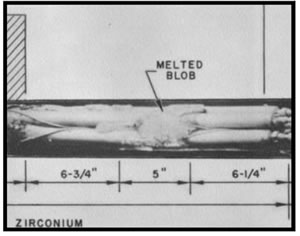Above – KNBC coverage of the meeting. (Note, the segment erroneously states that radiation from the 1959 meltdown was released into the San Gabriel Valley, when it meant San Fernando Valley.)
The October 1 meeting of the SSFL Work Group addressed critical questions about the site’s toxic nuclear history and concerns about whether it will ever be cleaned up.
The evening began with an excerpt from Warren Olney’s 1979 five-part series for KNBC, which was the first time the public was informed about the meltdown that had occurred at SSFL twenty years prior. The segment included footage of Atomics International workers attempting to deal with the nuclear reactor accident in which 13 of 43 fuel rods experienced melting. One of the workers shown in the film is John Pace. (See full Olney video here.)
Eyewitness to Meltdown – Pace, who now lives in Idaho, then took the stage and recounted his experiences working at the site during the accident. His moving first-person testimony described the build up of radioactive gas that was released into the atmosphere and into the Simi and San Fernando Valleys. (See video of Pace’s presentation left or here.)
At the time, Pace was told to keep quiet, “I was not supposed to say a word,” he said. “This is something I have to say to all of you. It’s very important to me to let you know what actually happened. It’s been with me 55 years.” (See an article in The Acorn about Pace here.)
[On October 20, DTSC issued a “Fact Sheet” in which it appeared to deny that the partial meltdown ever occurred. This contradicts what DTSC told the U.S. Court of Appeals in its brief on Dec. 12, 2011, “The worst incident was in 1959 when a partial meltdown of a sodium reactor at the site resulted in the release of radioactive gases to the atmosphere.” The Court of Appeals ruling on September 19, 2014, concurred, finding that “In 1959, one of the reactors experienced a partial meltdown that released radioactive gases into the atmosphere for three weeks.”]A panel discussion followed Pace which included former Atomics International employees Dan Parks and Bonnie Klea and Dr. Robert Dodge of Physicians for Social Responsibility-Los Angeles. (See video of panel discussion right or here.)
Parks said that there were other facilities on the site that were even more dangerous than the nuclear reactors, including the”hot cell” where radioactive fuel elements were dissected and sodium burn pits where barrels of highly toxic radioactive coolant were exploded. Bonnie Klea addressed the hurdles she and other former workers experienced trying to get compensation for illness caused by toxic exposure at DOE facilities. Dr. Dodge discussed the effects of radiation on health and the need for the site to be cleaned up.
Risks to Cleanup Agreements Revealed — Will SSFL Ever be Cleaned Up? Dan Hirsch of Committee to Bridge the Gap detailed how the SSFL cleanup has been undermined since the beginning of 2011. See video of Hirsch’s presentation left or here.
Hirsch relayed how Boeing, the Department of Energy, NASA, and DTSC have all recently taken actions that raise serious questions whether the cleanup obligations will be breached. Unless the community joins together and fights for full cleanup, the great majority of the radioactive and chemical contamination will never be cleaned up.
A panel of longtime community members and cleanup advocates discussed their decades of struggle to cleanup SSFL. The panel included Barbara Johnson and Marie Mason of the Rocketdyne Cleanup Coalition, former Atomics International employee Bonnie Klea, and Dr. Shel Plotkin of the Southern California Federation of Scientists.
Marie Mason told a story about how someone from the government had once said that everyone has a price on their head. She commented, “The government has a whole table of how much we’re all worth. And it’s worth it to the government if X amount of people die because it costs less. That’s great if you’re not the person who’s dying, or your loved one’s not the person whose dying. But that’s the way the government looks at it and that’s the way Boeing looks at it. I urge everyone one out there to get involved.” See video of panel discussion above or here.
The SSFL Work Group also urges you to become more involved in fighting to ensure that SSFL is truly cleaned up. The cleanup is a critical juncture, and your voice is needed. If you’d like more information about what you can do, please contact us here.

